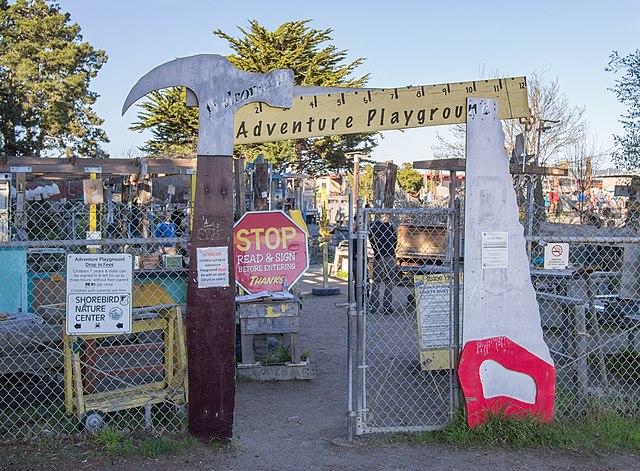Children need risks to thrive
Image of an adventure playground, commonly found in European countries.
In the modern world, every moment of a child’s life is calculated. They go to kindergarten at age 5. Playtimes are regularly scheduled and in the company of a watchful adult. Bedtime is at 7 p.m.. The list goes on.
While these safety nets are great for avoiding lawsuits, it is clear that being a kid in the 21st century lacks the risks that make life worth living. Children need simulated risks to thrive and build upon their creativity and motor skills, something that has been unfairly denied to them.
For instance, look at one place where simulated risks are missing and crucial: playgrounds.
For the most part, playgrounds are seemingly devoid of risks. Slides are gently sloped, platforms are barely off the ground and the worst scrape you can get is a couple pieces of mulch stuck in your knees.
There is no mutability in these plastic wastelands. Children cannot interact with the objects and build. They lack the ability to problem solve and assess risks around them. These plain structures may be perfect for safety, but it lacks the imagination and creativity that makes them worth the time.
Landscape architect Marjory Allen was famous for going against these types of playgrounds, and sought to advocate for a place for kids to explore by herself. She found a solution in what are known as adventure playgrounds.
Adventure playgrounds are full of building materials and tools for children to interact with. They require regular maintenance and upkeep, and are never exactly the same. In these environments, children are given the power to make their own playground and take risks when necessary.
According to the Play and Playground Encyclopedia, the original concept of these areas began in 1931.
“Sorensen, a Danish landscape and playground designer, saw children playing everywhere except at the traditional cement and asphalt playgrounds,” Play and Playground Encyclopedia said. “The idea that children would rather play with dirt, rocks, lumber, etc. started a revolution in the playground industry.”
These structures, while unconventional, open up new doors and avenues for children to play and interact with the world around them, cultivating creative thinking skills and aiding in development.
Although some may believe that these areas are full of safety hazards and room for improvement, there are a wide variety of benefits that make adventure playgrounds worth investing in.
According to Studio Ludo in a London study of adventure playgrounds, children were 18% more physically active in these simulated environments, these playgrounds were cheaper to construct and fewer injuries were reported.
When risks are present everywhere, children are more aware of them, and in turn develop better risk detection skills.
Engaging in risks increases the self-esteem of children who need it the most. Despite criticism from parents and those worried about safety, it is clear these playgrounds have demonstrated and established benefits.
Children deserve to have autonomy and make decisions in their free time as much as adults, albeit with more guidance. One of the worst things we can do for the next generation is to stop them from doing “dangerous” things carefully. In order to properly support them, we should encourage children to draw outside of the lines and build their own future.
Your donation will support the student journalists of GlenOak High School. Your contribution will allow us to purchase equipment and cover our annual website hosting costs.






